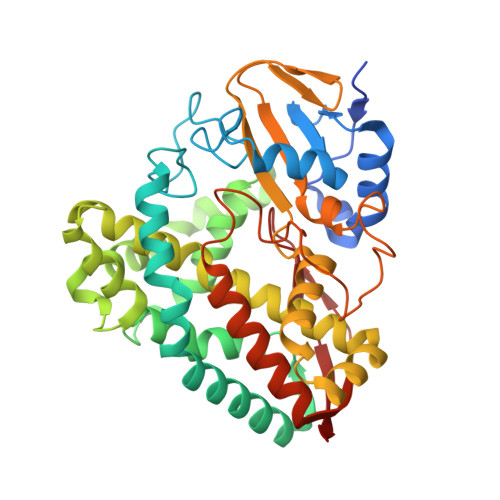Exploring the Factors which Result in Cytochrome P450 Catalyzed Desaturation Versus Hydroxylation.
Coleman, T., Doherty, D.Z., Zhang, T., Podgorski, M.N., Qiao, R., Lee, J.H.Z., Bruning, J.B., De Voss, J.J., Zhou, W., Bell, S.G.(2022) Chem Asian J 17: e202200986-e202200986
- PubMed: 36268769
- DOI: https://doi.org/10.1002/asia.202200986
- Primary Citation of Related Structures:
7R8S, 7UDF, 8E5J - PubMed Abstract:
The cytochrome P450 family of monooxygenase enzymes have essential biological roles involving the selective oxidation of carbon-hydrogen bonds. They can also catalyze other important metabolic reactions including desaturation to form alkenes. Currently the factors that control the partition between P450 hydroxylation and desaturation pathways are poorly defined. The CYP199A4 enzyme from the bacterium Rhodopseudomonas palustris HaA2 catalyzes the oxidation of 4-ethyl- and 4-isopropyl- benzoic acids with hydroxylation and desaturation occurring in significant quantities. Here we demonstrate that 4-cyclopropylbenzoic acid is regioselectively hydroxylated by CYP199A4 at the benzylic carbon. In contrast, the oxidation of 4-n-propylbenzoic acid by CYP199A4 results in three major metabolites: an alkene from desaturation and two hydroxylation products at the benzylic (C¦Á) and C¦Â carbons in similar quantities. Extending the length of the alkyl substituent resulted in 4-n-butylbenzoic acid being oxidized at the benzylic position (45%) and desaturated (55%). In contrast, 4-isobutylbenzoic generated very little alkene (5%) but was hydroxylated at the benzylic position (54%) and at the tertiary C¦Â position (41%). The oxidation of 4-n-propylbenzoic acid by the F298?V mutant of CYP199A4 occurred with no hydroxylation at C¦Â and a significant increase in metabolites arising from desaturation (73%). The X-ray crystal structures of CYP199A4 with each substrate revealed that they bind in the active site with the alkyl substituent positioned over the heme. However, the longer alkylbenzoic acids were bound in a different conformation as was 4-n-propylbenzoic acid in the F298?V mutant. Overall, the changes in metabolite distribution could be ascribed to bond strength differences and the position of the alkyl group relative to the heme.
Organizational Affiliation:
Department of Chemistry, University of Adelaide, Adelaide, SA, 5005, Australia.

















